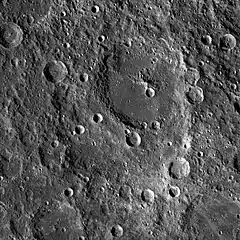Harkhebi (crater)
Harkhebi is a large lunar impact crater of the category termed a walled plain, on the far side. Half of the crater to the north-northeast is overlain by the walled plain Fabry, a large formation in its own right. Attached to the northwestern rim is the much smaller crater Vashakidze. To the southwest lies Vestine, and to the south is Richardson.
 LRO image | |
| Coordinates | 39.6°N 98.3°E |
|---|---|
| Diameter | 337 km |
| Depth | Unknown |
| Colongitude | 266° at sunrise |
| Eponym | Harkhebi |

What survives of the outer rim of Harkhebi is worn and eroded by impacts, leaving little of the original formation intact. To the southeast, sections of the rim are overlain by the satellite craters Harkhebi J and Harkhebi K. The remainder of the rim is irregular in form, creating an arc of rugged ridges, incisions, and small craters. Most of the interior floor is also uneven and rough in places, although somewhat less so than the surrounding terrain. Several small, bowl-shaped craters lie across the interior floor, including Harkhebi H next to the southern rim of Fabry.
Just to the southeast of Harkhebi is the young crater Giordano Bruno, a formation with a relatively high albedo lying at the center of a ray system. Streaks of this ray material lie across several parts of the interior floor of Harkhebi, and one of the rays spans the floor from southeast to northwest.
Prior to formal naming in 1979 by the IAU,[1] this crater was known as Basin I.[2]
Satellite craters
By convention these features are identified on lunar maps by placing the letter on the side of the crater midpoint that is closest to Harkhebi.
| Harkhebi | Latitude | Longitude | Diameter |
|---|---|---|---|
| H | 39.3° N | 99.8° E | 30 km |
| J | 37.4° N | 103.4° E | 40 km |
| K | 35.7° N | 100.8° E | 27 km |
| T | 40.1° N | 95.7° E | 16 km |
| U | 40.8° N | 97.0° E | 18 km |
| W | 43.5° N | 95.7° E | 17 km |
References
- Harkhebi, Gazetteer of Planetary Nomenclature, International Astronomical Union (IAU) Working Group for Planetary System Nomenclature (WGPSN)
- Lunar Farside Chart (LFC-1A)
- Andersson, L. E.; Whitaker, E. A. (1982). NASA Catalogue of Lunar Nomenclature. NASA RP-1097.CS1 maint: ref=harv (link)
- Blue, Jennifer (July 25, 2007). "Gazetteer of Planetary Nomenclature". USGS. Retrieved 2007-08-05.CS1 maint: ref=harv (link)
- Bussey, B.; Spudis, P. (2004). The Clementine Atlas of the Moon. New York: Cambridge University Press. ISBN 978-0-521-81528-4.CS1 maint: ref=harv (link)
- Cocks, Elijah E.; Cocks, Josiah C. (1995). Who's Who on the Moon: A Biographical Dictionary of Lunar Nomenclature. Tudor Publishers. ISBN 978-0-936389-27-1.CS1 maint: ref=harv (link)
- McDowell, Jonathan (July 15, 2007). "Lunar Nomenclature". Jonathan's Space Report. Retrieved 2007-10-24.CS1 maint: ref=harv (link)
- Menzel, D. H.; Minnaert, M.; Levin, B.; Dollfus, A.; Bell, B. (1971). "Report on Lunar Nomenclature by the Working Group of Commission 17 of the IAU". Space Science Reviews. 12 (2): 136–186. Bibcode:1971SSRv...12..136M. doi:10.1007/BF00171763.CS1 maint: ref=harv (link)
- Moore, Patrick (2001). On the Moon. Sterling Publishing Co. ISBN 978-0-304-35469-6.CS1 maint: ref=harv (link)
- Price, Fred W. (1988). The Moon Observer's Handbook. Cambridge University Press. ISBN 978-0-521-33500-3.CS1 maint: ref=harv (link)
- Rükl, Antonín (1990). Atlas of the Moon. Kalmbach Books. ISBN 978-0-913135-17-4.CS1 maint: ref=harv (link)
- Webb, Rev. T. W. (1962). Celestial Objects for Common Telescopes (6th revised ed.). Dover. ISBN 978-0-486-20917-3.CS1 maint: ref=harv (link)
- Whitaker, Ewen A. (1999). Mapping and Naming the Moon. Cambridge University Press. ISBN 978-0-521-62248-6.CS1 maint: ref=harv (link)
- Wlasuk, Peter T. (2000). Observing the Moon. Springer. ISBN 978-1-85233-193-1.CS1 maint: ref=harv (link)